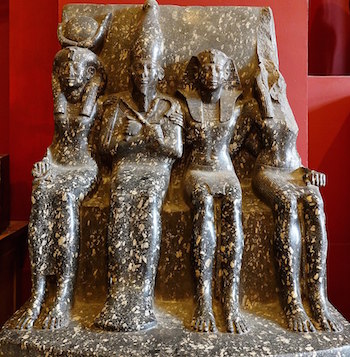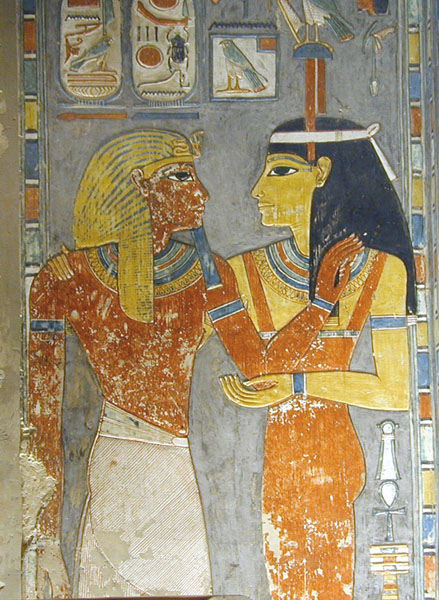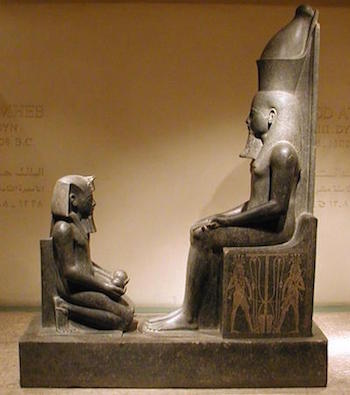Horemheb (“Horus is in festival”) was the last pharaoh of the eighteenth dynasty, but can also be considered as the founder of the nineteenth dynasty of Ancient Egypt. He rose from an obscure background to serve up to four kings of Egypt (Akhenaten, Smenkhare, Tutankhamun and Ay) before finally becoming pharaoh of ancient Egypt in his own right.
Booth suggests he was “either a genuine individual who was charismatic and trustworthy or a duplicitous man who was clever and deceitful, convincing each king of his loyalty whilst being loyal only to himself”.

Whether he is considered as a saint or a sinner depends in large part on a consideration of his role in events following the demise of the Atenist experiment of Akhenaten, the details of which are steeped in controversy and open to debate.
He has been described both as “the saviour and father of his country” (Weigal) and the “restorer of just and effective government” (Kitchen) or as a “military strongman” (Kemp) and “general without an inheritance” (Van de Meiroop) who tried to remove his predecessors from the historical record, usurped their monuments and on whose orders a Hittite prince was murdered.
It is largely agreed that Horemheb hailed from Hutnesut (Hansu, Hnes, or Herakleopolis). In his Coronation Decree he claimed that Horus of Hutnesut chose him to rule Egypt and dedicated a number of monuments to him once he was enthroned, but strangely there is no evidence that he undertook any building work at Hutnesut itself. His family background is similarly obscure. Dodson suggests he was of “provincial stock” and Gardiner noted that his Saqqara tomb contains “no mention of his parentage nor any likelihood that he was of high birth”.
Booth notes that he was probably from a middle class family as he was literate and that his father may have been a military scribe but this is simply conjecture as he does not name his father or mention his titles. We know very little about his early life. It is likely that he entered scribal training at the age of five and given his later titles he probably received military training. However, his early career may have been primarily administrative, as is implied by frequent depictions of Horemheb as a scribe and his continuing devotion to Thoth – although it is equally likely that this was simply a measure to reinforce his wisdom as a ruler.
Given his advanced position when Tutankhamun became pharaoh it is likely that he was an official during the reign of Akhenaten, although there is no evidence to confirm whether he lived in Akhetaten or was a follower of the Aten.
He is sometimes linked to an official named Paatenemheb (“The Aten is in festival”) who was commander in chief of the army of Akhenaten, but this connection is largely based on the similarity of their names and remains unproven and rejected by many scholars.

The first unambiguous identification of Horemheb is in his Saqqara tomb. In this tomb he charted his advancement through a series of administrative positions (“Scribe of Recruits ” up to “Royal Scribe” and “Overseer of all Overseers of Scribes of the King”), military roles (“General” then “Overseer of the Generals of the Two Lands”), and diplomatic posts (“King’s Envoy” and “Mouth who appeases in the Entire Land”).
There are depictions of Horemheb in his Saqqara tomb presenting captives from Syria and Nubia to the king and he claims that his name was “renowned in the land of the Hittites” suggesting that during the reign of Tutankhamun Horemheb was engaged in skirmishes with this foreign power. Redford suggested that the so called “Zizinia fragment” (which is alleged to come from Horemheb’s Saqqara tomb) depicted booty which Horemheb had gained during a successful campaign to the south while Hari and Aldred proposed that the fragment relates to his earlier career and depicts the fruits of a diplomatic mission. At this time he gained the title “iry-pat” which is translated by some as “hereditary prince” and this is taken as evidence that Horemheb would be the successor of the king should he die without producing an heir.

However, the name of his king is not confirmed. It could have been Tutankhamun (Van Dijk) or Ay (Kitchen, Hornung, Martin). Furthermore, the title is generally translated as “nobleman” and does not necessarily imply he was to be the successor of his king.
Although he may not have been the heir apparent during the rule of Tutankhamun he was probably the most powerful official – next to Ay. It is even possible that Horemheb and Ay were the effective rulers of the country at that time or that Horemheb himself controlled the young king.
When Tutankhamun died it was Ay, not Horemheb, who succeeded him. However, Ay’s reign was brief and soon Horemheb was able to claim the throne for himself. He was clearly delighted to become pharaoh and set about adding a royal ureas to the depictions of himself as an official in his Saqqara tomb. This clear sign of ego could tempt one to consider him as a great self-publicist intent on re-writing history to increase his renown. Yet, Van Dijk has noted the similarity in tone and content between the text in Horemheb’s Saqqara tomb and his Coronation Decree making it less likely that he was exaggerating his importance to support his rise to pharaoh. It was by no means uncommon for a pharaoh to assert that he was predestined to rule. Hatshepsut used this device to support her unconventional reign and as Horemheb was not the son of a pharaoh he may have felt the same need to prove he was legitimate.
His Coronation Decree was inscribed on a statue depicting Horemheb and his wife Mutnodjmet. The decree describes his early career, confirms that Horus of Hnes chose him to rule and that the oracle of Amun confirmed his position.
Kemp notes that Horemheb staged his coronation during the Opet festival because the connection between the king and Amun could be used to “convert usurpers … into models of legitimacy and tradition” and Gardiner notes that although Thebes was not the traditional location of the coronation, Horemheb’s choice was logical given the need to reconcile with the priests of Amun following the Atenist Heresy of Akhenaten.

Horemheb has perhaps unfairly been characterised simply as a military man with the implication that his military position allowed him to seize power. However, Spalinger comments that this is to fail to understand the role of the army in Ancient Egypt, and points out that Horemheb was a diplomat and administrator who even held the exalted post of Vizier before becoming pharaoh. Horemheb himself stresses his administrative prowess as much as his martial power in his Coronation Decree. He may also have had connections with the royal family through his wife Mutnodjmet who is considered by many to have been the sister of Nefertiti (although some commentators reject this connection).

The chain of events following the death of Tutankhamun is decidedly murky. It is usually proposed that Ay usurped Horemheb’s position and strove to disinherit him by naming Nakhmin (possibly a relative of Ay) as his successor. Van Dijk notes that it is almost certain that Horemheb was no longer viewed as the “heir apparent” during rule of Ay. However, he also suggests that Ay was only ever intended to be a temporary king (citing the fact that he retained the title “God’s father”, did not take any pharonic epithets such as nsw-bity before his cartouche, and wore the panther skin of a sem priest in the opening of the mouth scene in the tomb of Tutankhamun). However, it has also been noted by Dodson that Horemheb is named as the successor of Ay in the tomb of Ptahemhat-Ty (a high priest of Ptah) which is roughly contemporary.
Van de Meiroop suggests that when Horemheb did become pharaoh he “expressed his displeasure at having been upstaged” by removing Ay’s name from monuments and destroying the monuments of Nakhtmin. However, Booth has suggested that Horemheb was not moved by petty revenge and that as an ultra-traditionalist defender of Ma’at he was happy to allow the elderly Ay (as the surviving male member of the previous dynasty) to rule knowing that he would not live long. The text of the Coronation Decree is ambiguous but could be interpreted as confirming that Ay (as the living Horus) named him as heir (although Gardiner notes that it could also mean that Horemheb carried the cult statue of Horus of Hnes to Karnak) so it is possible that Ay and Horemheb worked together to achieve their common goal of restoring Egypt to glory. There is no definitive evidence to confirm the position one way or another, however, his destruction of the monuments of Nakhmin would suggest that there had been an attempt to prevent Horemheb gaining the throne.
Horemheb did usurp the mortuary temple of Ay (and numerous monuments of Tutankhamun), but Ay had himself already usurped this monument from Tutankhamun. Ay’s tomb was certainly defaced but Booth suggests that Horemheb caused only “cosmetic” damage and limited his attacks on Ay to the Theban area and that it was the Ramesside kings who undertook more consistent attacks on the memory of Ay.
Horemheb also began to dismantle the temples of the Aten at Karnak during his fifteenth year (using the blocks as fillers for his own buildings) and may also have begun to dismantle the city of Akhetaten, yet this may have been pragmatic and political rather than personal and vindictive. Hornung has suggested that “Haremheb in no way contemplated an obliteration of the Amarna period but rather attempted to combine tradition with revolution and thus to initiate a new and practicable course of action”.
It is notable that his Edict does not contain a direct attack on the Amarna period rulers (unlike the denunciation in Tutankhamun’s Restoration Stele which was later usurped by Horemheb). The wrongful acts described as those of officials and soldiers and the measures protected his tax revenue and shielded the common people from the corruption of officials. Weigal commented that these measures showed “how near to his heart were the interests of his people”. However, Pfluger notes that his actions were not altruistic, stemming as they did from “the necessity of popularising and therefore stabilising his regime”. Numerous other types of offence were left to the kenbet courts to decide and his reorganisation of these courts shows that he was conservative and preferred men of rank over laypersons.
The Edict is generally seen as a reaction to the chaos under Akhenaten but it could equally describe the situation under Tutankhamun or refer to Horemheb’s deeds as an official of Tutankhamun. Yet, Aldred was probably right to note that his national tour ensured the application of these measures and his reign “did much to re-establish the government of Egypt on sound and effective lines”.
Horemheb is often accused of the murder of the Hittite prince Zanzana. Opinion favours Ankhenesamun as the author of a letter allegedly sent to the Hittite king requesting a husband (Aldred, Scneider, Kitchen).
Dodson has suggested that the burial of Tutankhamun was delayed by up to eight months because of the attempt to negotiate this marriage while Van Dijk proposes that Ay initially took power as an interim measure while the marriage was negotiated at his suggestion – although this seems rather unlikely.

In the end, the unfortunate Hittite apparently perished before reaching Egypt and it has been speculated that he was murdered en route by forces loyal to Horemheb (Van Dijk) or executed on Ay’s orders (Kitchen) and Hornung proposes that Horemheb had to repel a retaliatory raid shortly after.
Booth has queried the authenticity of the letter noting that Egyptian kings would not even allow their daughters to marry foreign princes, although in this case it was a queen who was negotiating her own wedding so that point may not be valid here. Booth further notes that the only copy of this letter (and replies to it) are to be found in the Hittite archives and proposes that the whole incident was a propagandist invention of the Hittites. There is also a letter in the Hittite archive purporting to be from Ay in which the pharaoh denies any involvement in the murder of the Hittite prince but again we only have the Hittite report of the contents and tone of the letter. It may be stretching credulity to suggest the Hittites were routinely falsifying their own records without any real evidence to support this practice.
Whether or not the letter existed, the events surrounding the death of the Hittite prince have proved excellent grounds for conspiracy theories. For example, El Mahdy has suggested that Ay composed the letter then leaked its contents knowing that Horemheb would not allow such a match. Then, while Horemheb was marching to intercept the Hittite prince, Ay had himself crowned as pharaoh!
Like his predecessor Akhenaten, Horemheb has been viewed as both saint and sinner. He was certainly an ambitious man, but also seems to have been a balanced ruler who genuinely wished to see his country prosper. He was clearly confident of his own ability, but perhaps rightly so as he seems to have earned the respect and loyalty of others. He may have had a military background, but he valued learning and was an effective administrator who understood the importance of re-establishing the connection between the king, the gods, and the people. Most importantly, by clearly designating an heir he knew he could rely upon and who already had an established family, he ensured stability and prosperity for Egypt’s future.
Pharaoh’s Names
Horus name: Kanakht Sepedsekheru
Nebty name: Werbiatemipetsut
Golden Falcon name: Horhermaatsekhepertawy
Prenomen: Djeserkheperure Setepenre

Nomen: Horemheb Meryamun

Bibliography
- Aldred, Cyril (1970) “The Foreign Gifts offered to Pharaoh” p105-116 Journal of Egyptian Archaeology
- Aldred, Cyril (2000) “The reign of Horemheb” p71-76 The Cambridge Ancient History Ed I.E.S Edwards
- Aldred, Cyril (1988) Akhenaten, king of Egypt
- Booth, Charlotte (2009) Horemheb the forgotten pharaoh
- Dodson, Aidan (2000) Monarchs of the Nile
- Gardiner, Alan (1953a) “The coronation of King Haremhab” p13-31 Journal of Egyptian Archaeology
- Gardiner, Alan (1953b) “The Memphite Tomb of general Haremhab” p3-12 Journal of Egyptian Archeology
- Hornung, Eric (1999) History of Ancient Egypt
- Kitchen, Kenneth (1982) Pharaoh Triumphant: The Life and Times of Ramesses II, King of Egypt
- O’Connor, David (2005) “New Kingdom and Third Intermediate Period” p183-278 in Ancient Egypt a Social History ed Trigger et all
- Pfluger, Kurt (1946) “The Edict of Haremhab” p260-276 Journal of Near Eastern Studies
- Martin, Geoffrey (1991) The hidden tombs of Memphis
- Murnane, William J (1995)”The Kingship of the Nineteenth Dynasty, a study in the resilience of an institution” (p185-220) in Ancient Egyptian kingship Ed David O’Connor, David P. Silverman
- Schneider, Hans D (2001) Horemheb p114-116 Oxford Encyclopaedia of Ancient Egypt Vol 2 Ed D Redford
- Van de Meiroop, Marc (2011) A History of Ancient Egypt
- Van Dijk, Jacobus (1993) “Horemheb, Prince Regent of Tutankhamun” (pp. 1064) New Kingdom Necropolis of Memphis: Historical and Iconographical Studies
- Van Dijk, Jacobus (2000) “The Amarna Period and the Later New Kingdom” p265-307 from Oxford History of Ancient Egypt Ed Ian Shaw
- Weigal, Arthur (1923) The Glory of the Pharaohs
Copyright J Hill 2012